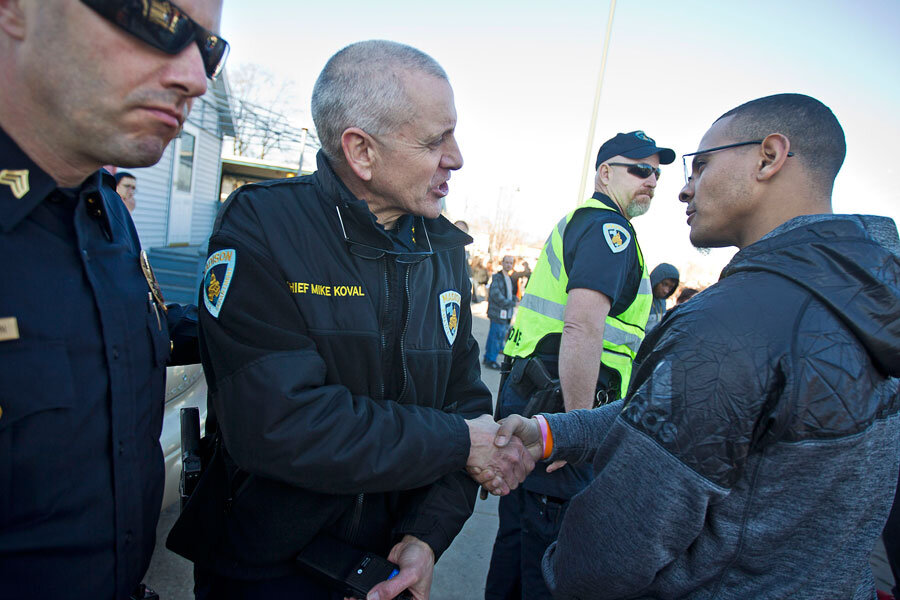How Madison avoided becoming another Ferguson
Loading...
Paul Soglin, the mayor of Madison, Wis., was understandably loath to compare his city to Ferguson, Mo., when asked to do so last week, saying he didn't want to "reflect on that."
For good reason. The comparisons begin with recent community unrest over the police shooting of an unarmed minority teen and would seem largely to end there. Ferguson is two-thirds black, Madison is less than one-twelfth black (7 percent). Madison is a thriving college town that pulses with a counterculture protest ethic, Ferguson is a product of black migration and white flight that has suppressed its racial tension for generations.
Yet in the comparison of Ferguson and Madison, lessons begin to emerge. Because Madison, for all its liberal traditions, has its own racial tensions. Madison, for all its progressive-minded citizens, still has a police department that shot and killed four suspects in a two-year span from 2012 to 2014.
To be sure, Madison and Ferguson are different. But Madison has its problems, too, and how it has responded to the shooting death of an unarmed, biracial teen has offered a glimpse at how the nation might be able to move forward on the emotionally and legally fraught issue of officer-involved shootings.
Madison and the state of Wisconsin have won praise even from the family of the young man killed on March 6 for how they are handling the investigation. Amid continuing protests, the city's Police Department has, as much as possible, built goodwill instead of distrust. And from the first moments after the shooting, neither the mayor nor the police chief has taken an "us versus them" stand, but rather each has stressed that this was a tragic event that the justice system must unravel impartially.
In Ferguson and even New York City, the protests that took place after officer-involved deaths unleashed deep divisions. For the most part, police were on one side and protesters on the other – often literally, separated by barricades and riot gear.
In Ferguson, police at first refused to name the officer who had shot Michael Brown, then released a video of Mr. Brown roughing up a local store clerk as he stole mini-cigars from a liquor store. In New York, the head of a police union accused Mayor Bill de Blasio of recklessly inflaming protests against the police. When two police officers were later killed in an ambush, the union chief said there was "blood on the hands" of city hall.
Madison has taken a dramatically different tack. Mayor Soglin and Police Chief Mike Koval met with the family of slain teen Tony Robinson the night he died. Mr. Koval has also apologized – not saying his officer is guilty, but expressing remorse for the killing. He's taken some heat from beat cops for this, a local union chief told the Milwaukee Journal-Sentinel. But even the union leader expressed solidarity with Koval.
"The family is going through a tragedy. The shooting is still under investigation. He's just expressing that the family has suffered a loss," said Jim Palmer, executive director of the Wisconsin Professional Police Association. "To publicly express regret. I thought that was proactive and important."
Koval's directions to police since the shooting have been to embrace the community – even if that seems difficult – not hold it at baton's length.
"I've asked my officers to park the car, get out and walk, get out and be visible. Have those courageous conversations as people would allow. Play a game of horse on the basketball court," he told NPR. "We need to show that we are members of the community as well."
Koval has refused to discuss Mr. Robinson's conviction of armed robbery last year, saying it is not relevant to the case. And according to a new Wisconsin law, the shooting will be probed, not by the police, but by independent investigators.
All this has given the Robinson family confidence that justice will be carried out.
"I trust Wisconsin and the way they're handling the investigation," Robinson's uncle Turin Carter told reporters. "We don't want our biases involved, we don't want anybody else's."
Questions still exist about Madison police officers' use of deadly force. Last October, Wisconsin State Journal columnist Chris Rickert wrote that "a string of officer-involved shootings beginning in 2012 brought allegations of a trigger-happy department." Though all the shootings were deemed to be justified by investigators, one led to the new Wisconsin law about independent investigators, Mr. Rickert noted.
But before last week, Madison had shown a degree of progress, defusing "a pair of dangerous situations over the last two weeks without anyone getting hurt," Rickert wrote at the time.
Madison still has work to do on race relations, too, according to a 2012 report by the Wisconsin Council on Children and Families. It found that Dane County, which includes Madison, had eight African-American adults arrested for every one white adult. Nationwide, the ratio is 2.5 to 1.
"Madison is the worst place a black person can live," Meaca Moore, a student at the University of Wisconsin at Madison, told Reuters, saying that the isolation of the local black community makes blacks feel like a "freak show."
Megaphone in hand, Mayor Soglin attempted to address such disparities in addressing protesters last week. He took some abuse from protesters, according to reports. But a former Vietnam War protester himself, Soglin was not fazed. Instead, during the past week, he's seen a city grappling with important issues without resorting to violence and lawlessness.
"We're a pretty good city. We’re not perfect," said Soglin to reporters Monday. "I would say that our response as a community since Friday night is as caring and as wonderful as anyone could imagine."






